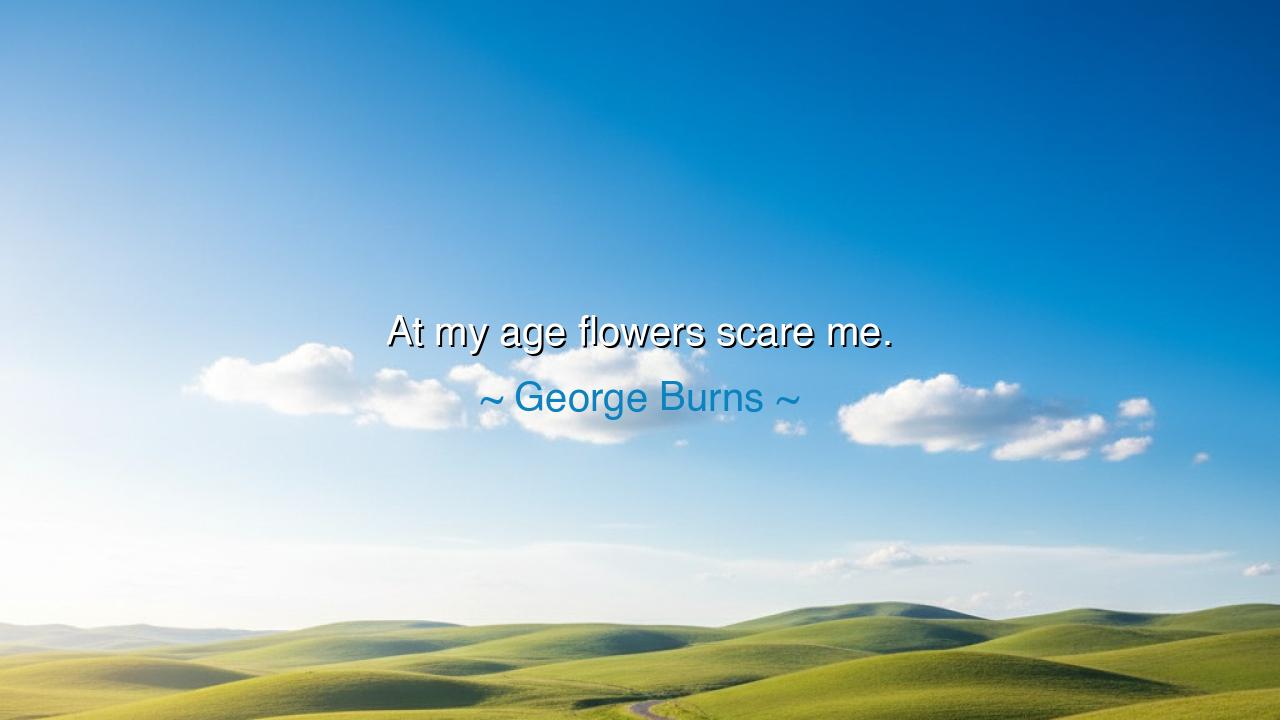
At my age flowers scare me.






In the quiet and inevitable march of time, as the years accumulate, the world around us often begins to take on a different shade. The words of George Burns, the celebrated comedian and actor, encapsulate this shifting perception: “At my age flowers scare me.” These words, spoken with the dry humor for which Burns was known, carry a deeper, poignant truth about the experience of growing older. Flowers, symbols of beauty and life, begin to take on a different meaning when viewed through the lens of advancing years. They are no longer mere things of joy and renewal but reminders of the fragility of life, the transient nature of beauty, and the inexorable march toward mortality.
What, then, does it mean when Burns says that flowers scare him? Flowers, in their vibrant bloom, are often seen as symbols of youth, new beginnings, and the promise of life’s vitality. Yet, for one who has lived many years, these very symbols can become fraught with a deeper, perhaps unsettling meaning. Flowers, so often associated with spring and renewal, also have a short life span—they bloom and wither, a reflection of the fleeting nature of all things. To Burns, they serve as a reminder that life, too, has its seasons, and as one grows older, the fleeting beauty of the world around us becomes more poignant, more elusive. The fear is not of the flowers themselves, but of what they represent—change, decay, and the inevitable decline that comes with the passage of time.
In the ancient world, flowers were not only seen as emblems of beauty but also as symbols of impermanence. The Greeks spoke of the transitory nature of life through the image of the rose, often associating it with the fleetingness of youth and love. The great philosopher Heraclitus famously said, “You cannot step into the same river twice,” speaking to the ever-changing nature of existence. To the ancients, every flower’s bloom was a reminder that all things—youth, beauty, and even life itself—were subject to the ravages of time. As we grow older, we come to understand this truth more deeply. Burns’ words reflect this ancient awareness that everything is in a constant state of flux, and that our time in the world is limited, no matter how brightly we may shine in our youth.
Consider the example of Socrates, who in his later years, faced the certainty of his own mortality with the same clarity that he had approached life’s questions. He was sentenced to death, and in his final days, he spoke calmly of the transition between life and death, suggesting that it was no more to be feared than a peaceful sleep. The flowers of life, for Socrates, were the experiences and lessons we gain along the way, each moment fleeting, but filled with meaning. The lesson, then, is not that aging is to be feared, but that the awareness of our impermanence can bring with it a deeper appreciation for the fleeting beauty of life.
Similarly, the great poet William Shakespeare, in his sonnet "That time of year thou mayst in me behold," captures the beauty and sorrow of the aging process. “When yellow leaves, or none, or few, do hang / Upon those boughs which shake against the cold, / Bare ruined choirs, where late the sweet birds sang.” In this sonnet, Shakespeare speaks of the seasonal cycles of life, where each stage, like the blooming of flowers, must eventually come to an end. But it is in this awareness of life’s fragility that we find a sense of purpose. Just as the flowers bloom brightly before fading, so too do our lives—brief yet full of profound significance.
So what lesson can we take from Burns’ words? First, we must recognize that aging is not something to be feared, but something to be understood and embraced. The beauty of youth and the vibrancy of life are indeed fleeting, but that does not diminish their value. The key is to cherish the present, to live fully in each moment, knowing that each bloom—whether a flower or a stage of life—is part of the larger journey. Burns’ acknowledgment of the fear that comes with aging does not seek to diminish the joy of life, but to remind us that we must be mindful of our own mortality. This mindfulness, rather than being something that burdens us, should encourage us to live with greater intention, knowing that our time is limited.
Therefore, let us celebrate each stage of life, even as we face the inevitable changes and challenges that come with time. Just as flowers bloom, so too do we, each at our own time, and each with our own unique beauty. Let us find courage in Burns’ reflection, not to fear the passage of time but to make the most of the moments we have, knowing that our legacy, like the flowers, is not in the length of its bloom but in the vibrance it brings to the world while it lasts. Just as we care for the flowers, let us care for ourselves, for each moment holds the potential for beauty, even in the face of life’s impermanence.






AAdministratorAdministrator
Welcome, honored guests. Please leave a comment, we will respond soon